


III. NEOWISE Single-exposure Images
III.2. Cautionary Notes
III.2.c. Image Anomalies and Features
Many of the single-exposure image anomalies seen in the Post-Cryo Data Release (section VIII.2.b.i) are also seen in the NEOWISE Reactivation
images. On this page we discuss anomalies that have not been noted before
or ones that are not new but are rare.
Each figure below shows one row of images per frameset. Each image is
47x47 arcminutes square. From left to right are shown the full
single-exposure frame for W1, W2, broken icons for bands W3 and W4
(because these two bands were not active during the NEOWISE mission) and
a three-color image comprised of blue (W1 only) + green (an average of
W1 and W2) + red (W2 only). The frameset number is shown at far left.
Click on the thumbnails to see the images at higher resolution. Readers
are encouraged to preview these same images using the WISE image service
at IRSA and to download the FITS files for further study. To aid the
reader, values of the frame_ID are provided in the caption of each
figure.
NB: For the final data release, figure numbering has been
updated to sequential integers. External citations to this
document published prior to November 2024 may thus refer to outdated figure numbers.
Image examples below are divided into the following categories:
Electronic effects:
The effects discussed here are similar to ones seen in the Post-Cryo
data but either show different features or are sufficiently rare and
unusual that a reminder here is prudent. Additional details on these
artifacts can be seen in section VIII.2.b.i of the All-Sky Explanatory
Supplement.
Electronic effects: "TV test patterns"
 |
| Figure 1 - Single-exposure frameset 65354a111. On rare
occasions, rectangular areas of the array show elevated backgrounds, a phenomenon that has been seen
before (see section II.4.b.ii
of the All-Sky Explanatory Supplement). The affected areas in W1 and W2
run orthogonal to
the read-out channels. In this case, the images also show a diffuse glow
in regions along
the right and bottom edges. The cause of these "TV test patterns" -- so
called because of the blocky patterning of bright colors seen in the
two-color image -- is not known. |
 |
| Figure 2 - Single-exposure framesets
24937r069-071.
Frameset 070 illustrates another "TV test pattern" that, as with all
other examples, has
its affected W1 and W2 areas running orthogonal to the read-out
channels. In this case, the images also show a diffuse glow in regions
along the right and bottom edges, multiple diagonal features
across both arrays, and a subtle signal jump in W2 near the middle of
the array. |
 |
| Figure 3 - Single-exposure frameset 65477a009.
This is another instance of "TV test pattern". These images also show a strange glint-like artifact. |
 |
| Figure 4 - Single-exposure framesets 33764r091-093.
Frameset 091 illustrates another "TV test pattern". The images in 091 also show
a strange fan-like glint, primarily in W2. |
 |
| Figure 5 - Single-exposure framesets 24496r163-165.
Frameset 164 illustrates another "TV test pattern". The images in 164 also show a
possible satellite trail at the upper left corner, a band perpendicular to the
trail running to the lower right, and a nearly horizontal band near the
bottom of the arrays. The cause of these bands is not known.
|
 |
| Figure 6 - Single-exposure frameset 66085a077.
This is another instance of a "TV test pattern".
The images also show a swath, possibly indicative of a
fly-by, that appears morphologically similar to the "flying doughnuts"
in Figures 76-92 of this section. |
 |
| Figure 7 - Single-exposure frameset 93514a092.
This is another instance of a "TV test pattern".
The W2 array also exhibits two small notches of higher backgrounds that
protrude into the rectangular area of lower backgrounds. A detailed
view is shown in Figure 8 below. A hint of this phenomenon is also seen in Figure 1. |
 |
| Figure 8 - Single-exposure frameset 93514a092.
This is
a zoomed-in version of the "TV test pattern" in Figure 7 showing the
small notches of high backgrounds that protrude into the lower
background rectangle in W2. |
 |
| Figure 9 - Single-exposure frameset 99043a007.
This is another instance of a "TV test pattern". The
W2 array exhibits a small notch of higher background that protrudes
into the rectangular area of lower background. A detailed view is shown
in Figure 10 below. This phenomenon is also seen in Figures 1, 7, and 8. |
 |
| Figure 10 - Single-exposure frameset 99043a007.
This is
a zoomed-in version of the "TV test pattern" from Figure 9 showing the
small notch of high W2 background that protrudes into the lower background
rectangle in W2. |
 |
| Figure 11 - Single-exposure frameset 03544r216.
This is
another example of the "TV test pattern" phenomenon, but in this case
the W2 image shows
another elevated, wedge-shaped region in the bottom third of the
array. |
 |
| Figure 12 - Single-exposure frameset
15260r123. In this "TV test pattern", areas of the array show
saturated backgrounds in the raw data, which were then converted to a
NaN signal by the pipeline. The delimiter lines between the saturated and normal
background regions of each array are very bright, and show the steep
transition of signal in between. |
 |
| Figure 13 - Single-exposure frameset
17108r193. This is another instance of a "TV test pattern". Unlike typical instances of
this phenomenon, in which the signal jumps in a sharp step, the signal
here changes gradually across the array, as can be seen in Figure 14, below. |
 |
| Figure 14 - Single-exposure frameset 17108r193.
Signal medians over columns and over rows are shown for the W1 (left
panel) and W2 (right panel) arrays described in Figure 13, above. The
left panel shows that the median row signal in W1 (red line) drops
gradually from the bottom of the array to the top, and that it exhibits
banding or rippling. The right panel shows that the median column signal
in W2 (green line) rises gradually towards the right side of the array. |
 |
| Figure 15 - Single-exposure framesets 52876r205-206.
The "TV test pattern" in frameset 205 shows a narrow wedge-shaped region of elevated counts in W2
in addition to the usual rectangular region of elevated counts.
|
 |
| Figure 16 - Single-exposure frameset 60499r043.
The "TV test pattern" shown here exhibits another wedge-shaped region of
higher W1 and W2 counts along the upper right edge of the arrays.
|
 |
| Figure 17 - Single-exposure frameset 63508r129.
This "TV test pattern" shows a broad diagonal swath of higher W1 and W2
counts in addition to the usual high rectangular backgrounds. This swath
could be caused by an out-of-focus fly-by like those seen in Figures
76-92 of this section.
|
Electronic effects: "Resonant pixel" effects
 |
| Figure 18 - Single-exposure framesets 48672a105-107. This is a rare anomaly, dubbed the "resonant pixel" effect, described in section III.2.c.ii.
Frameset 105 has high backgrounds and an unusual illumination pattern.
This frameset also failed to complete processing, so its color-composite
image is not available. Subsequent frames show areas on both
arrays where a latent-like signal slowly decays. (Click image for an
annotation.) All known examples of this effect are listed in section III.2.c.ii.
|
Electronic effects: Increased partial channel noise
 |
| Figure 19 - Single-exposure frameset 55122a056. Increased backgrounds and
noise are seen in portions of four W1 readout channels. |
Electronic effects: Columns of NaNs
 |
| Figure 20 - Single-exposure frameset 65288a269. In the
presence of a saturating source (the Tarantula Nebula, in this case),
a column of NaNs is created near the left edge of the W1 array. The location of this
column varies, as shown in Figures 21, 22, and 23 below. |
 |
| Figure 21 - Single-exposure frameset 66982a023. The bright star R Doradus creates a column of NaNs in W1, much like the one caused by the Tarantula Nebula in Figure 20, In this case, the affected column is shifted a few pixels to the left of the one seen in Figure 20. |
 |
| Figure 22 - Single-exposure frameset 97712a115.
This is another instance of a column of NaNs in W1 created in the
presence of a saturating source. In this case the offender is Moon glow. |
 |
| Figure 23 - Single-exposure frameset 03389r087.
This is another instance of a column of NaNs in W1, created in this case by the
presence of Betelgeuse. This column of NaNs is
closer to the center of the array than other examples above. |
Electronic effects: Unusual cosmic ray effects
 |
| Figure 24 - Single-exposure frameset 70118a257.
A cosmic ray in W2 exhibits
a semi-circular shape as a result of its having struck partway through the read-out. |
 |
| Figure 25 - Single-exposure frameset 75065a051. A
cosmic ray in W1 exhibits a semi-circular shape for the same reason given in Figure 24.
|
 |
| Figure 26 - Single-exposure frameset 63814a078. A
radiation hit in W1 produces a small, point-like but saturated detection
(pure blue) toward the center of the frame. |
 |
| Figure 27 - Single-exposure frameset 86204a253. A
radiation hit in W2 produces a somewhat larger (compared to Figure 26), point-like but saturated
detection (yellow) in the lower left quadrant of the frame. |
 |
| Figure 28 - Single-exposure frameset 92331a261. A
radiation hit in W1 exhibits a "shadow" effect. This effect is likely
from a bad pixel clump that blocks charge transfer to radially more
distant pixels. See Figures 34-36 for other shadow examples. |
Electronic effects: Latents from unusual sources
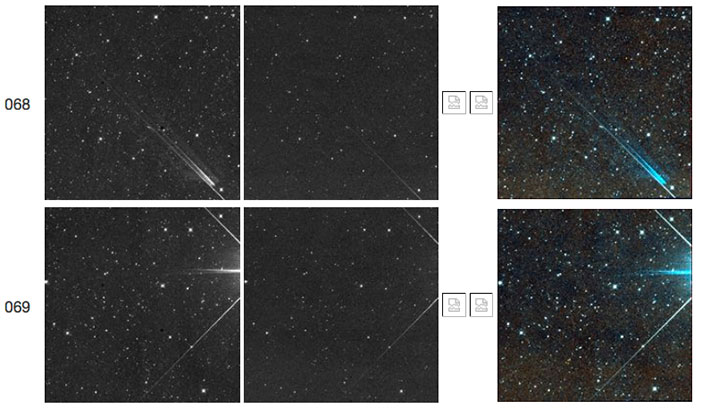 |
| Figure 29 - Single-exposure frameset 80973a236-239.
A latent is seen on the right side of W2 frames 237 and 239 despite the fact that there
is no obvious parent object at the same array position in frame 236. The
bright source producing this latent likely crossed the field of
view just after that portion of W2 frame 236 was read out. |
 |
| Figure 30 - Single-exposure frameset 82165b198-201.
A latent is seen in W2 frames 199, 200, and 201. The source of this
latent is the smeared image of the bright star R Doradus, created when the scan
mirror was flipped to take frameset 199. The bright part of the latent
falls in the long-decay, short-term latent area discussed in section III.2.c.ii.3 and also seen in other figures such as Figure 18 (the location of the "resonant pixel" effect in W2) and Figure 29. |
 |
| Figure 31 - Single-exposure frameset 83161b215-218.
A latent is seen in W1 frames 216 and 217. The source of this latent is
a powerful radiation hit in frame 215. |
 |
| Figure 32 - Single-exposure frameset 83354a022-025.
A latent is seen in W2 frames 023-025. The source of this latent was
not captured in the earlier images, presumably because it moved through
the field after that part of the array was read out for frame 022. |
 |
| Figure 33 - Single-exposure framesets
30092r239-241. This example shows glow from an object off the bottom
edge of frameset 239 and a latent (in frameset 240) of a satellite trail
that moved through the field of view between framesets 239 and 240.
Moon glow is also
present here. |
Effects from Bright Objects:
The character of bright object artifacts in the NEOWISE Reactivation
data is similar to that seen in the Post-Cryo data. Details on these
artifacts can be seen in section VIII.2.b.i in the All-Sky Explanatory Supplement. The particular effects discussed here are not mentioned in the Post-Cryo documentation.
Effects from bright objects: Pixel shadows
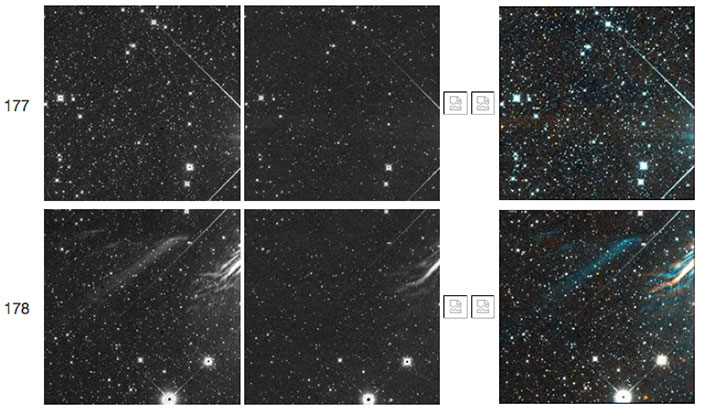 |
| Figure 34 - Single-exposure frameset 45613b175.
Clumps of bad pixels can block charge from leaking into neighboring pixels. These pixel groups are
masked during processing because of their abnormal
sensitivities. In
this example, such an area of masked pixels (black in the image) is seen on
the left edge of the halo of bright star W Hydrae. |
 |
| Figure 35 - Single-exposure frameset 97056a051. The effect seen in Figure 34
at W1 can also be seen at W2, as shown here. A cone of shadowed pixels
is shielded from leaked charge due to a clump of bad pixels lying
between it and the core of the bright carbon star GY Camelopardalis. A
detailed image is shown
in Figure 36. |
 |
| Figure 36 - Single-exposure frameset 97056a051. This is a zoomed-in version of the W2 image shown in Figure 35. |
Effects from bright objects: Extended ghosts
The following extended ghosts have been seen in W1.
 |
| Figure 37 - Single-exposure frameset 52900a184. The
ghost light to the left of the bright star in the W1 image occurs when a bright object
lands directly on a clump of bad pixels
near the X,Y position 610,377 on the W1 array. A possibly related instance was noted in
previous WISE data releases; see the second panel of Figure 55
in section VIII.2.b.i of the Post-Cryo documentation. Similar instances on the W1 array are illustrated in
Figures 38-51 below and in Figure 26b of section II.4.b.ii of the AllSky documentation. Examples in W2 are shown below in Figures 52-54. |
 |
| Figure 38 - Single-exposure frameset 44642r023.
This is a more dramatic example of the ghosting seen from a bright star
landing at X,Y position 610,377 on the W1 array. |
 |
| Figure 39 - Single-exposure frameset 62509b238.
This is another example of extended ghosting caused by a bright star
near the X,Y position 610,377 on the W1 array. In this case, the ghost
has reduced intensity and lands very close to the star itself. |
 |
| Figure 40 - Single-exposure frameset 72718a083.
As in Figures 37, 38, and 39,
a bright star lands near the X,Y position 610,377 on the W1 array, but
in this case the extended ghosting falls largely to the right, not the
left, of the star. |
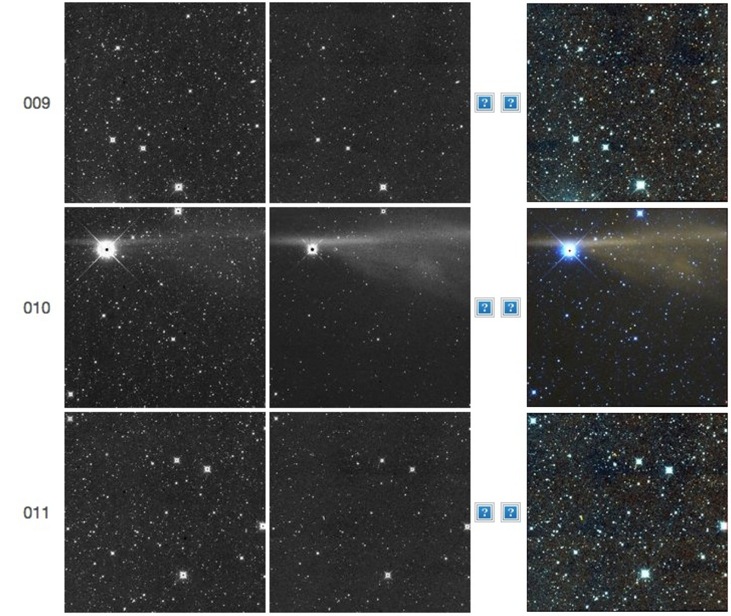 |
| Figure 41 - Single-exposure frameset 73017a224.
This is another instance of extended ghosting from a star near X,Y =
610,377. In this case, the W1 ghosting is more multi-directional. |
 |
| Figure 42 - Single-exposure frameset 92925a129.
As with Figure 41, a bright star falls near X,Y = 610,377 but the multi-directional W1 ghost is more dramatic. |
 |
| Figure 43 - Single-exposure frameset 55846a189. This example shows W1 extended ghosting from a bright star falling
near X,Y = 387,389. |
 |
| Figure 44 - Single-exposure frameset 65032a021. This instance of W1 extended ghosting is caused by a star falling near X,Y = 117,947. |
 |
| Figure 45 - Single-exposure frameset 80264a192. This is another example of W1 extended ghosting, this time from a bright star falling near X,Y = 226,901. |
 |
| Figure 46 - Single-exposure frameset 81405a197.
Although W1 ghosting has been seen in this part of the array (at X,Y =
899,522) ever since the 4-band cryo mission, this is one of the brightest stars ever noted at that position. |
 |
| Figure 47 - Single-exposure frameset 86284a001. The W1 ghosting in this image is caused by a bright star at X,Y = 963,603. |
 |
| Figure 48 - Single-exposure frameset 12081r055.
The W1 ghosting in this image is caused by a bright star at X,Y =
302,614. The cluster of bad pixels causing this ghosting is the same
one causing the pixel shadow in Figure 34. |
 |
| Figure 49 - Single-exposure frameset 18979r039. The W1 ghosting in this image is caused by a bright star at X,Y = 588,798. |
 |
| Figure 50 - Single-exposure frameset 21725r042.
The W1 ghosting in this image is caused by the core of a
bright star falling near a clump of pixels at X,Y = 790,601. |
 |
| Figure 51 - Single-exposure frameset 47316r081.
The W1 ghosting in this image is caused by the
bright star falling on the righthand side of the array near X,Y =
1016,709. (This may be a glint rather than a ghost, however. See, as
another example, Figure 67.) |
The following extended ghosts have been seen in W2.
 |
| Figure 52 - Single-exposure frameset 02222r196. The W2 ghosting in this image is caused by a bright star at X,Y = 773,489. |
 |
| Figure 53 - Single-exposure frameset 61147r136. The dramatic W2 ghosting in this image is also caused by a bright star at X,Y = 773,489. |
 |
| Figure 54 - Single-exposure frameset 07653r234.
The W2 ghosting in this image, which is far more subtle than other examples
above, is caused by a bright star at X,Y = 66,549. |
Effects from bright objects: Dark rectangular regions in W1, in presence of off-array source
 |
| Figure 55 - Single-exposure framesets
48781a125-126. A very bright source off the right side of the field
of view causes a glow across the arrays. Frames exhibit a
dark rectangular region on the left side of the W1 array, on the opposite side from
the source. Although the glow
itself has been seen in previous WISE data releases
(see Figure 15
of section VIII.2.b.i of the Post-Cryo documentation), the dark
rectangle in W1 is new in NEOWISE Reactivation images and is seen only
in pipeline-processed data. It is not present in the raw data. When there is a large background gradient perpendicular to the
detector read-out channels, the pipeline has
difficulty correcting for the channel-to-channel variations, resulting
in large residual backgrounds. Although pipeline modifications were made
to mitigate this effect, some instances, such as the one illustrated
here, still occur.
|
 |
| Figure 56 - Single-exposure frameset 78349a120.
As in Figure 55, this is a rare pipeline-created effect that produces a step in the W1
backgrounds. In this case, the cause is extremely high count levels caused by
scattered moonlight.
|
 |
| Figure 57 - Single-exposure framesets
88659a012-014. This is another instance of rare pipeline-created artifacts
in the W1 backgrounds, this time produced by scattered light from a very
bright star off the right edge of the frameset.
|
Effects from bright objects: Glints from point sources
Although glints from bright point sources were seen during previous phases of the
mission (All-Sky,
3-band Cryo, and
Post-Cryo data releases), some manifestations are more
prominent in the NEOWISE Reactivation data.
A comparison and study of the temporal evolution of glints across the
All-Sky and NEOWISE 2016 Data Releases is shown in Section III.2.c.i.
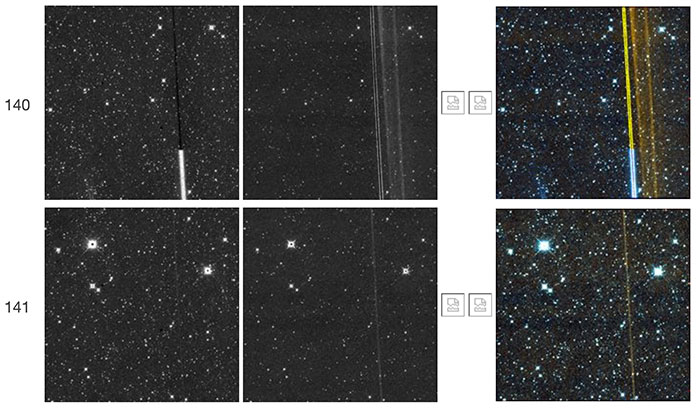 |
| Figure 58 - Single-exposure framesets 55538b027-028.
The glint running diagonally in the lower-right corner of frameset 027 coincides with a diffraction spike. The bright star
responsible for these features is just off the right-hand side edge of
framest 028. |
 |
| Figure 59 - Single-exposure framesets
88670a068-069. Similar to Figure 58, the glint shown here is parallel to but not coincident with the diffraction spike of the star responsible for creating it. |
 |
| Figure 60 - Single-exposure framesets 65198a172-173.
The sickle-shaped colorful glint in frameset 173 is produced by the bright
star just off the right-hand side edge of framest 172. The glint exhibits an
unusual shadow running diagonally across a significant portion of the W1 and
W2 arrays. The shadow is not parallel to the diffraction spikes from the
star but likely points back to the star's position. |
 |
| Figure 61 - Single-exposure framesets 59049a017-018.
The elaborate glint in 017 is produced by the bright
star in 018. |
 |
| Figure 62 - Single-exposure framesets 58041b089-090.
The tenuous W1-bright glint near the bottom edge of frame 089 is produced
by the bright star in 090. |
 |
| Figure 63 - Single-exposure framesets
76477b027-029. The W1 glint in 029 in the
top left of the array is caused by the bright source just
outside the field of view of 027. |
 |
| Figure 64 - Single-exposure framesets
79009b177-178. Frameset 178 shows another unusual glint,
from a bright star just outside the field of view in frameset 177. |
 |
| Figure 65 - Single-exposure frameset 57729a216. A prominent
W2 glint is seen from a bright source off the right-hand edge of the arrays. |
 |
| Figure 66 - Single-exposure frameset 87274a244-245.
The bright star in frameset 245 creates a semi-circular W1 glint on
either side of the familiar spray-like W1 glint in frameset 245. |
 |
| Figure 67 - Single-exposure frameset 08161r191.
The bright star just off the edge of the frameset creates an additional
W1 glow along its diffraction spike. |
Effects from bright objects: Severe glow from the Moon
 |
| Figure 68 - Single-exposure framesets 61181a123-128.
Many of the patterns of stray moonlight seen in NEOWISE Reactivation are
similar to those seen in earlier data releases. This example is unusually
prominent; the curved feature at the upper-left corner of framesets 124-126,
particularly strong in the latter, is not present in 128, but is instead
replaced by vertical bars along the right-hand side. |
Effects from bright objects: Possible close fly-bys
 |
| Figure 69 - Single-exposure framesets 62256a211-213.
The diagonal glow prominent in W2 in frame 211 and an unusual
wishbone-shaped glint in 213 are likely caused by a very bright object moving
just off the field of view. |
 |
| Figure 70 - Single-exposure framesets 87752a187-188.
Frameset 188 shows a bright glint from a very bright satellite that moved through the field of view in frameset 187. |
 |
| Figure 71 - Single-exposure framesets 59797b015-017.
The bright feature towards the upper-left corner of frameset 016 is likely a glint a moving
object just outside of the field of view. |
 |
| Figure 72 - Single-exposure framesets
64993a009-011. The extended feature in frameset 010 is likely the glint
from an object that passed just outside of the field of view. |
 |
| Figure 73 - Single-exposure frameset 76409b015. The
bright extended feature is likely a ghost from an object that passed just outside of the field of view. |
 |
| Figure 74 - Single-exposure frameset 74800a028.
This is another example of a glint likely caused by a bright, moving object just outside of the field of view. |
 |
| Figure 75 - Single-exposure framesets
76421a007-008. The diffuse feature in 008 is possibly a glint from the
bright moving object seen in frame 007. |
 |
| Figure 76 - Single-exposure frameset 71737b123. The unusual fan-like feature in 123 is possibly related to an object passing just outside of the field of view. |
 |
| Figure 77 - Single-exposure framesets
77530a078-082. The features shown here are likely caused by out-of-focus pieces of debris passing through the field of
view: a large (but faint) doughnut-shaped detection in
frameset 078, edge glows in 079 and 081, and a bright out-of-focus
smear in 082. |
 |
| Figure 78 - Single-exposure framesets 80599a286. An out-of-focus object moves through the field of view. |
 |
| Figure 79 - Single-exposure framesets
84067a202-203. The broad W2-bright trail seen here in frameset 203 may be
caused by a piece of out-of-focus debris passing through the field of view. |
 |
| Figure 80 - Single-exposure framesets
84600a113-123. This sequence shows a rather dramatic rise in background
levels, presumably caused by an extremely bright but unknown object just outside of
the field of view in many of these framesets. In particular, note the ringing structure evident in framesets 118 and 119. |
 |
| Figure 81 - Single-exposure framesets
94688a106-111. This sequence shows another dramatic rise in background
levels, presumably caused by an extremely bright object just outside of
the field of view in many of these framesets. Although this
pattern resembles ordinary Moon glow, the Moon was about 113 degrees
away from this field so could not be the cause. |
 |
| Figure 82 - Single-exposure framesets
87578a066-068. Frameset 067 shows a smeared "doughnut", a telltale sign
of a nearby, out-of-focus source moving through the field of view. |
 |
| Figure 83 - Single-exposure framesets
16440r195-196. Frameset 196 shows another example of a smeared, out-of-focus source moving through the field of view. |
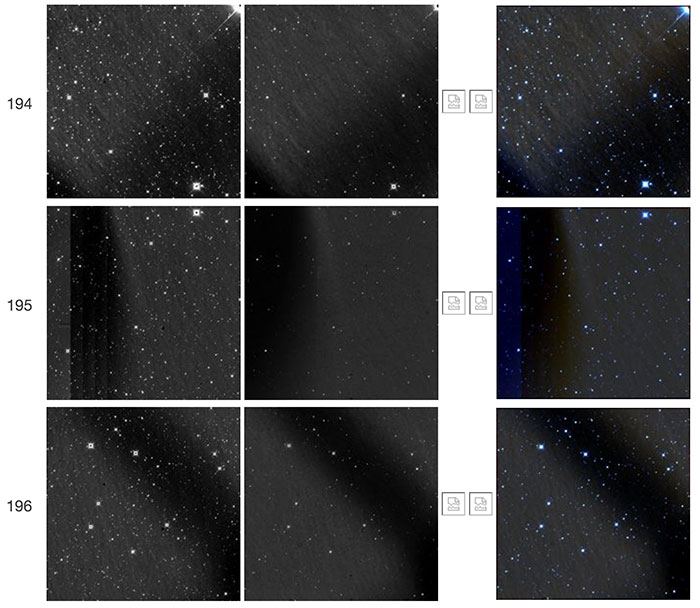 |
| Figure 84 - Single-exposure framesets
21734r194-196. These framesets show a nearer out-of-focus object moving through the field of view. |
 |
| Figure 85 - Single-exposure frameset 21734r201.
This is another example of an out-of-focus object moving through the field of view. This object is
seen shortly after the out-of-focus object seen in Figure 84. |
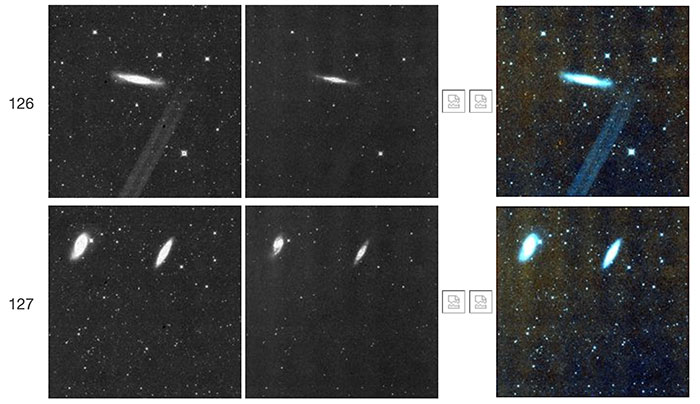 |
| Figure 86 - Single-exposure framesets
23214r126-127. Frameset 126 shows another out-of-focus object moving through the field of view.
Framesets 126 and 127 contain the interacting galaxies known as the Leo
Triplet. |
 |
| Figure 87 - Single-exposure framesets
91993a197-199. Frameset 197 shows another out-of-focus object moving through the field of view.
Frameset 199 shows a smeared glint, likely from this
moving source. The two galaxies in these images are M81 and M82. |
 |
| Figure 88 - Single-exposure frameset 11960r044.
This frameset shows a slightly smeared,
out-of-focus source moving through the field of view. The galaxy at
lower right is M106. |
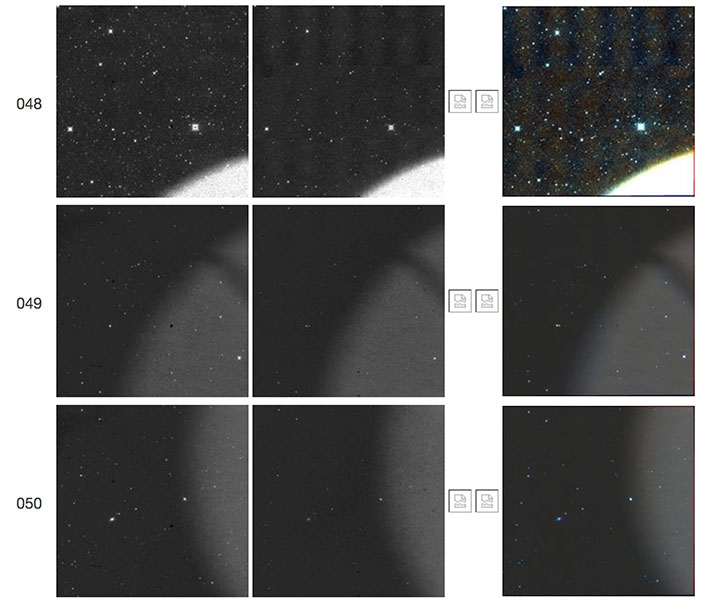 |
| Figure 89 - Single-exposure frameset
11960r048-050. These framesets show another out-of-focus source moving
through the field of view. This sequence occurs shortly after the
out-of-focus object seen in Figure 88. |
 |
| Figure 90 - Single-exposure framesets
29492r144-146. Framesets 144-145 show another out-of-focus source moving
through the field of view. Other framesets in this scan, such as 146,
exhibit mild Moon glow. In earlier framesets, this scan exhibits an instance of the "resonant
pixel" effect, as shown in Figure 34 of section III.2.c.ii. |
 |
| Figure 91 - Single-exposure framesets
39506r077-079. Frameset 078 shows another out-of-focus object on the
left-hand-side edge. The sharp edge of the "doughnut" suggests the source is not
moving as fast as other instances above. A "TV
test pattern" is also present in the frameset. The preceding and
following framesets do not exhibit any unusual features. |
 |
| Figure 92 - Single-exposure frameset 51839r244-246.
Frameset 245 shows a "TV test pattern" with mild signal jumps. Interestingly, the
area to the upper left of the frameset indicates the presence of a close, out-of-focus
object passing just outside of the field of view. This image lends
additional evidence to the idea that the "TV
test pattern" phenomenon
and fly-bys may be related. (See also Figures 90 and 91.)
|
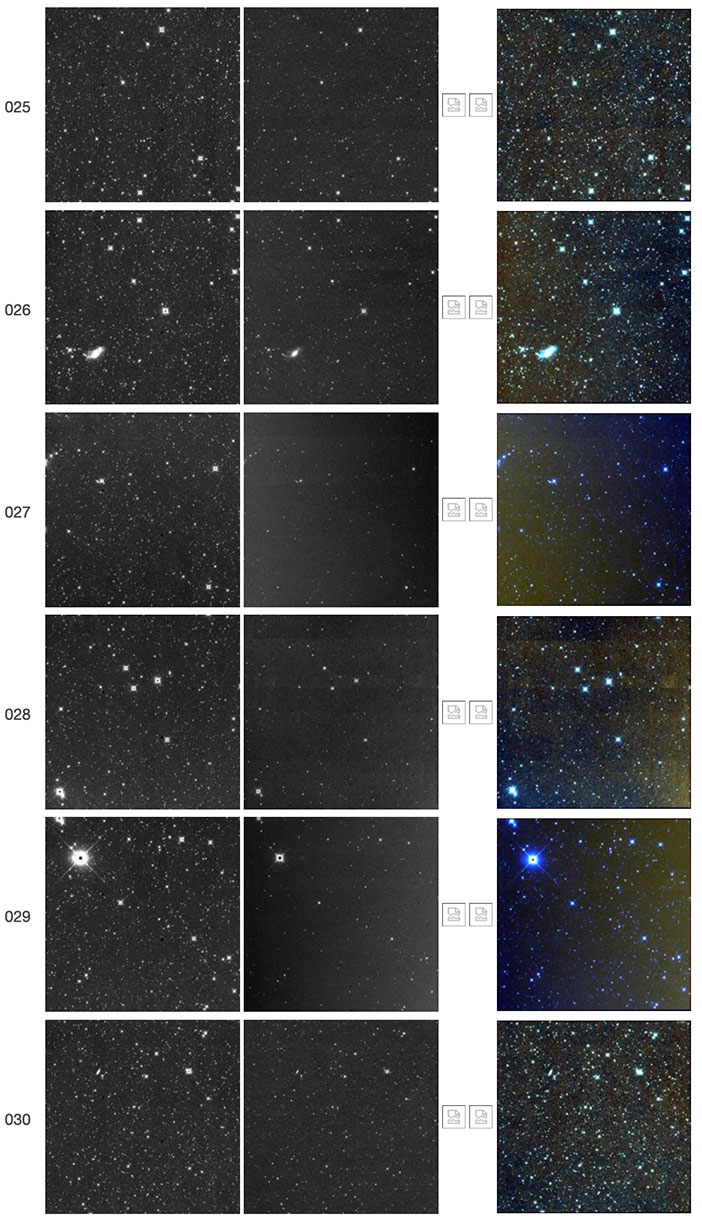 |
| Figure 93 - Single-exposure framesets
54592r025-030. Irregular background illumination, particularly in
framesets 027-029, mimics the glow seen when the Moon is just
outside the field of view. This scan, however, is on the opposite
side of the sky from the Moon, indicating that another very bright, illuminating
source, perhaps a bright satellite or a piece of space
debris, just outside the field of view is responsible. |
Effects from bright objects: Odd latents from sources smeared by spacecraft maneuvers
 |
| Figure 94 - Single-exposure framesets 66917a002-006.
The W2 feature near the right-hand side is a latent from R Doradus. It is smeared because R Dor
was observed before the scan -- during a spacecraft maneuver in engineering
framesets previous to the scan -- and was itself smeared. |
Effects from Bright Objects: Satellite flashes, tumbling satellites, and orbital debris
 |
| Figure 95 - Single-exposure frameset 78992a092. These images show a satellite trail with a single, moderate flash along its course.
|
 |
| Figure 96 - Single-exposure frameset 80576a232.
This satellite in this instance has a bright flash, but only on the
portion of its trail capture by the W1 array.
|
 |
| Figure 97 - Single-exposure framesets
62870r188-189.
This is a bright satellite trail with (a) sharp cut-offs caused by the
read-out pattern in frameset 188 and (b) a broad latent in frameset 189.
|
 |
| Figure 98 - Single-exposure frameset 81747a206.
Although not a bright effect, this rapidly tumbling satellite creates a
dotted line diagonally across most of the field of view.
|
 |
| Figure 99 - Single-exposure frameset 87508a040. This satellite has a slower tumbling rate than that in Figure 98. |
 |
| Figure 100 - Single-exposure frameset 95197a218.
This may be another instance of a tumbling satellite trail. In this case,
the tumbling is seen in the dark segment of the trail. This dark segment
is a common phenomenon, due to read-out differential timing effects. A
detailed view is shown below in Figure 101. |
 |
| Figure 101 - Single-exposure frameset 95197a218. This is a zoomed-in version of the satellite trail shown in Figure 100. |
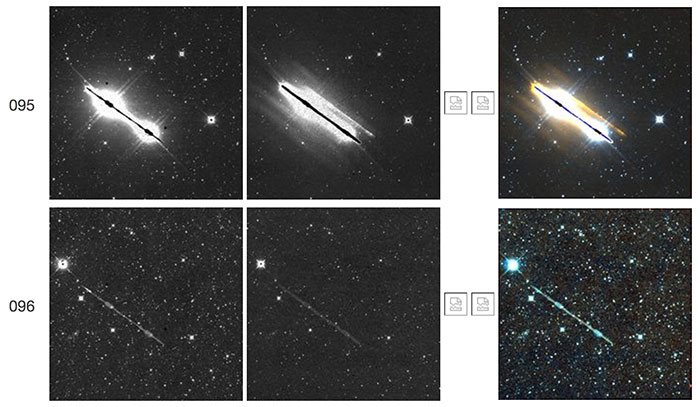 |
| Figure 102 - Single-exposure framesets
97991a095-096.
The bright feature -- with ghosts and diffraction spikes in frameset 095
and a latent in 096 -- were caused by a very bright, tumbling satellite. |
 |
| Figure 103 - Single-exposure framesets
62180r054.
This is another tumbling satellite for which the read-out electronics have contributed to a colorful string-of-pearls effect. |
 |
| Figure 104 - Single-exposure framesets
90026a125-127.
The saturated, smeared feature with ghosts in frameset 125 and
a latent in 127 was caused by a specular reflection of sunlight
off of a high-altitude satellite. |
 |
| Figure 105 - Single-exposure frameset 35867r203.
The short trail exhibits a dramatic brightening caused by specular
reflection of sunlight off a satellite component. To the right of the
bright region in W2 is a streaked ghost. |
 |
| Figure 106 - Single-exposure framesets 88642a082-084. This satellite trail shows a dramatic flash near the top of the field of view. |
 |
| Figure 107 - Single-exposure framesets
01807r140-142. Frameset 141 shows a series of W2-bright diagonal streaks
that are not seen in either the preceding or following framesets. The
streaks were caused by orbital debris above NEOWISE. This NEOWISE image
was taken on 2019 Jan 05 UT, and the debris is from ORBCOMM's first
generation (OG1) satellite that broke up just a few days before, on 2018
Dec 22 UT. At least twenty streaks can be discerned at higher contrast
in W2. |
 |
| Figure 108 - Single-exposure framesets
21850r140-141. Frameset 140 shows a satellite trail of unusual
appearance. It was partially read in W1 but only its latents were
seen in W2. The broad ghost, to the right of the latent in 140,
is curiously not exactly parallel to the
trail itself. |
 |
| Figure 109 - Single-exposure framesets
30404r062-064. Frameset 063 shows a satellite trail of unusual
appearance.
Figure 110 shows the W1 frame of 063 at a
different image scale
and exhibits three thick, parallel tracks. The three
tracks are core-saturated in W2 and their Level-1b pixels are
consequently NaNed, indicated by the dark swaths in the W2 image.
The trail and latents shown here could be caused either by one
massively bright satellite trail or multiple, closely spaced ones.
|
 |
| Figure 110 - Single-exposure frameset
30404r063. This is another version of the W1 frame
shown in the middle row in Figure 109, but at a different image
stretch to enhance detail. |
 |
| Figure 111 - Single-exposure frameset
60102r156. This is another instance of a satellite trail/latent similar to that shown in Figure 109. |
 |
| Figure 112 - Single-exposure framesets
22250r074-075. The short but dramatic satellite trail in frameset
074 is saturated at its core, and leaves a latent in frameset
075. The trail is not entirely horizontal, but frameset 074 shows a
horizontal linear feature running across the arrays. The linear
feature is of unknown nature in W1, but it is related to the
channel-bias correction applied by the pipeline in W2, as described
in Figure 113. |
 |
| Figure 113 (Left panel)- Two views of single-exposure frameset
22250r074 from Figure 112. (Left panel) The raw (Level-0) W2
frame. (Right panel) The
pipeline-processed (Level-1b) W2 frame. The image scale of both
figures has been heavily stretched. The left panel shows
the satellite
trail but not the horizontal line evident in Figure 112,
whereas the
right panel shows the horizontal line and
bright and dark linear features along it. The pipeline has trouble
computing the
channel bias correction here because the single W2 channel along which
the trail runs has both very high levels (in the trail) and normal
levels (beyond either end of the trail). |
 |
| Figure 114 - Single-exposure framesets
60932r101-102. This is another satellite trail causing a channel bias correction issue similar to that seen in Figure 112, as seen by the bright horizontal streaks evident in the W2 image of frameset 101. |
 |
| Figure 115 - Single-exposure framesets 62156r175-176. This is a satellite trail causing a channel bias correction issue very similar to that seen in Figure 112, as seen by the dark horizontal streak in the W2 image of frameset 175. |
Astrometric effects:
Rare anomalies in the astrometric reconstruction may be seen near the equatorial poles.
Astrometric effects: Band-to-band differences in rotation angle
An unusual feature may be seen in the color-composite mosaics when
the center of the framesets is very near the equatorial poles. The
feature consists of an apparent rotational difference between the two
bands, leading to a slight misregistration. It is possible the lack of precision from small-angle approximation leads to small but discernible differences in the rotation matrices of the W1 and W2 frames.
 |
| Figure 116 - Single-exposure frameset 37562r244. The astrometric reconstructions of the W1 and W2 images are slightly rotated with respect to each other. In this case, the center of frames is within 0.009 degrees of the south equatorial pole. The computed rotation angle, WCROTA2, for the two bands differs by approximately 4 degrees, unlike a typical difference of <0.2 degrees for framesets away from the poles. It is possible a small-angle precision problem leads to this effect. There have been other instances of this effect in NEOWISE Reactivation and earlier data releases, but those showed much smaller differences. |
Last update: 13 November 2024

























































































































